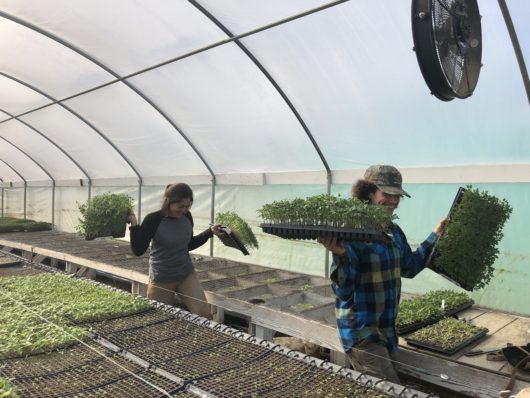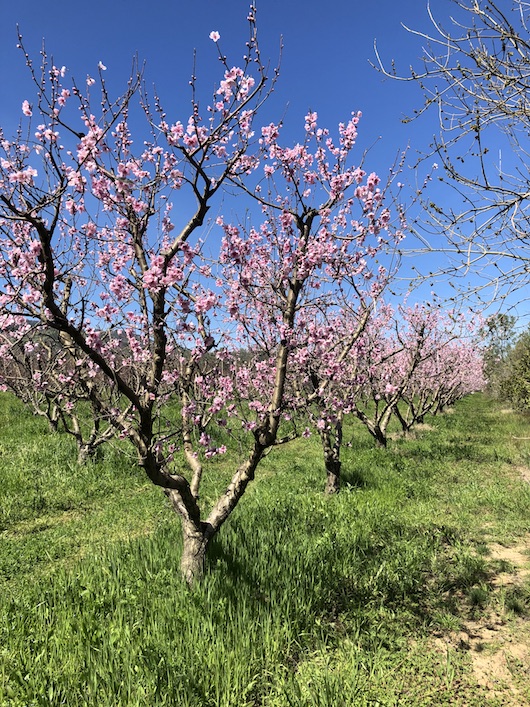Thinking about peaches ––
Oh Spring! You have descended upon us this past week, gracing field, hillside, and human spirit with the seduction of warmth and days that stretch out like a cat after a long slumber. This year you have been away longer than normal – the cold and rain of January, February and early March now all but forgotten with your bursting on the scene. The trees have been patiently awaiting your beckoning call. Our peaches and plums are finally blooming nearly a month late. Apricots and pears are swelling…
Everywhere on the farm there are blooms. Unharvested mustard, cabbage and turnip plants send their spike of a brilliant yellow flower upward. Arugula blooms a showy white and pink. The flowers become a feast for a whole array of flying insects. Hungry bees, lady beetles, lacewings, bumblebees and so many others show up to our table to be fed and bulk up after a long and cold winter. Their diet here is varied –a little almond pollen mixed with the yellow of mustard, or the pink of a pea, some showy white plum nectar rounded off with pollen and nectar from common weeds – groundsel, chicory, plantain or shepherd’s purse. We try to provide a healthy smorgasbord for a hungry insect.
Dear Spring, we are now finding ourselves fully engaged with you. There is much to do – planting, transplanting, weeding, picking and getting soil ready for the next round of crops – so much to catch up on. We are shaking off the sleepiness of long nights and cranking up the energy. Forget the calendar, straighten up, ready the guest bedroom, feel the energy of the band striking up, the dance is starting, for spring has arrived!
The gifts of life and renewal grace our farm. Dru and I are proud grandparents once again because Daughter Hallie and Husband Diego have added a nine-pound Pablo to their home this past week. Hale, hearty, round faced and with a full head of jet-black hair, Pablo was born at home, a remarkable and beautiful miracle. He joins the 140 lambs, a new litter of 12 pigs and an array of youngsters in the neighborhood. We do our work to make the world bountiful for this next group of stewards, connecting them to tangible beauty in a diverse well-tended farm.
We all have only so many springs in our lives. To be seduced is to become open, receptive and available, brimming with hope. It is less to do with the calendar and more with the surge of energy and purpose. To be a farmer who plants and tends the earth is to be one with this rhythm.
There are those who feel that the future of agriculture will be determined by the application of technology to the fields. Visions of autonomous tractors being commanded by farmers at their computer terminals juggling seed genetics and fertilizers in programs that are precise – no judgement errors, no applying too much of this additive or herbicide in a responsible mix of horsepower, technology and tools. Farmers like myself would be liberated from the drudgery of listening to those bees ramp up, or getting a feel for the time when the soil is exactly right preparing it to plant. The 15 or so mixes of cover crop seed that I planted last fall were all subject to the unique winter of 2018/2019. We got a chance this year to witness the resilience of each combination and store that information away in a body of experience. In the future, a drone would no doubt be able to do an assay of estimated nitrogen and carbon sequestration and interface that with a program for planting our tomatoes. Maybe…
While there is much that we will learn as new tools become available for measurement and problem solving, a shovelful of soil in the springtime can show history, biology, process, decay or life. Fifty worms per square foot translates to a million per acre and a churning of soil and castings that becomes like livestock grazing our subsoil. We simply need to feed them and house them and they jump to the beckoning of spring. It is a bit imprecise, and wildly complex, but if we acknowledge the capacities of living soil where each teaspoon is home to a billion microorganisms, we may not need the fertilizers, herbicides, insecticides, or other tools of ‘precision’ farming.
I think that the beauty of our association with this farm lies in the journey to get into a deeper relationship. Our tenure here requires us to look a little more closely with humility and awe. We may change our thinking about our farming practices as a program made of distinct unrelated disciplines and more as a whole in which we are profoundly entangled. We are beginning to understand that the food we choose is our culture in more ways than one. How produce is grown may determine its contribution to our health in both a nutrient sense and in a biological sense. You share this microbial connection to our farm, to our management of our soils and to the beautiful complexity of the layers of life on this land. At the same time how we choose to steward our land is at the heart of our culture as a people here for but a short time – handing off our legacy on the land to young Clemantine, Hazel or Pablo.
My friend, Will Allen, a fine farmer from Cedar Circle Farm related a notion given to him by his father. He said that, “the day that you are the best farmer you will ever be is the day you die.” There is so much to learn about this vibrant planet in our dynamic set of dynamic relationships – each year different, each piece that is near eternal, lasting long after we are gone. Celebrate the radiant push and energy of spring and enjoy its seduction. This season offers lessons and moments designed to cultivate our sense of awe. Grab your shovel, a good deal of mulch, a pack of seeds and scratch out a place, for spring is calling.
—Paul Muller

Tomato seedlings moving from heated greenhouse to “hardening off” greenhouse in preparation for transplanting later this month.

